
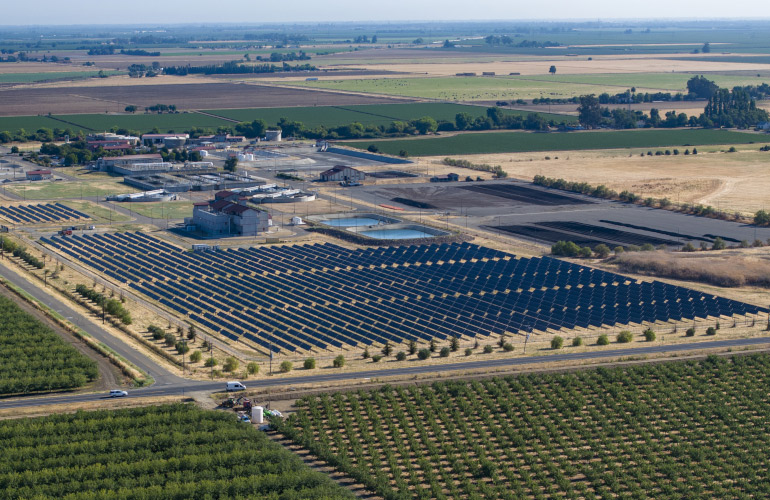
ForeFront Power is celebrating the completion of a 5-megawatt solar project at the Eastern Wastewater Treatment Plant (EWWTP) in Vacaville, California. There is also an energy storage system on site, but the specific details of the system scale have not been announced yet. The EWWTP system will generate nearly 8.1 million kWh of renewable energy electricity annually. The system aims to offset the annual electricity demand of EWWTP facilities and is expected to save the city over $25 million in electricity bills. Vacaville's sustainable development goals are about bringing better outcomes to people - healthier air, smarter resource utilization, and reliable public services, "said Vacaville Mayor John Carli. By combining solar energy with intelligent battery storage in an industrial facility that processes 7.5 million gallons of wastewater per day, this project will help power operations that are critical to minimizing public health risks and our environmental impact. EWWTP's solar and energy storage systems were developed through a 20-year PPA (Power Purchase Agreement) signed between the city and ForeFront Power. According to the terms of the PPA, ForeFront Power owns and maintains the system, while the city purchases electricity at a fixed low price lower than the utility company, ensuring long-term budget predictability and avoiding the impact of rate increases. ForeFront Power will continue to operate and maintain the system free of charge to the city during the PPA period.
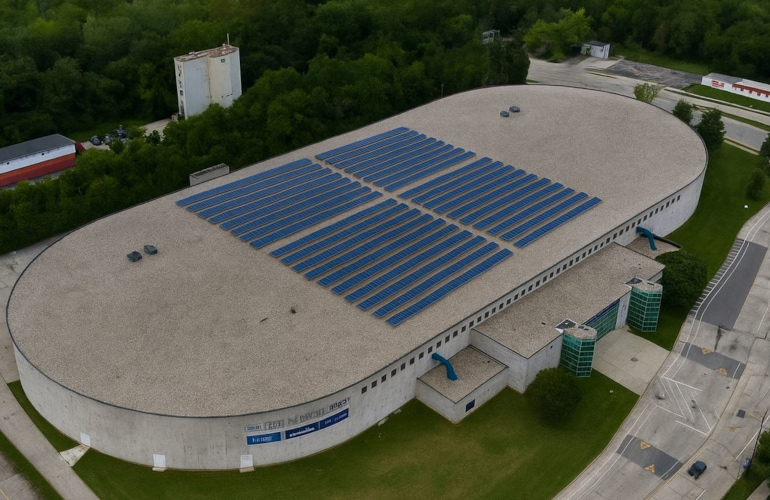
Since 1992, the Milwaukee Pet National Glacier Center has been a beloved community institution located in Wisconsin, where Arch Solar has installed a 690 kW rooftop solar system. Covering over 200000 square feet of ice, including nearly 97000 square feet of ice, the Ponty National Ice Center is a 501 (c) (3) non-profit organization and one of the largest indoor ice rinks in the United States. Maintaining its controlled climate and ice conditions requires a significant amount of energy, making sustainability its top priority. The new solar array is expected to reach 20% of the facility's annual energy usage, thereby reducing operating costs. The savings from renewable energy will be reinvested in operational and capital improvements, helping to ensure that future generations can enjoy this world-class site. At Petit National Glacier Center, we are proud of this bold sustainable future initiative, "said General Manager Paul Golomski. The installation of our rooftop solar arrays is not just an investment in clean energy - it is our commitment to the community, athletes, and future generations. Arch Solar designed the system to offset up to 100% of peak energy loads during spring and summer. The array is equipped with 1180 double-sided solar panels, installed on customized brackets, and will generate over 815000 kilowatt hours of electricity annually. The Peppa National Ice Center is doing some very unique work by using solar energy to cool down multiple ice rinks, "said Andrew Holmstr ö m, head of business development at solar company Arch Solar. This project demonstrates how a commitment to sustainable development can strengthen communities and increase profits. This initiative is thanks to the generous donation from the VoLo Foundation, a charitable organization dedicated to sustainable solutions and environmental advocacy. The VoLo Foundation has a deep connection with ice skating and has been a long-term supporter of the Petit Center's mission. At the VoLo Foundation, we are proud to support Petit National Glacier Center in reducing its carbon footprint by installing solar panels, "said founders David S. Vogel and Thais Lopez Vogel. The performance of the system will be monitored to ensure its efficiency and benefit the communities it serves. Together, we are driving a future driven by wise choices, where all of us can thrive.
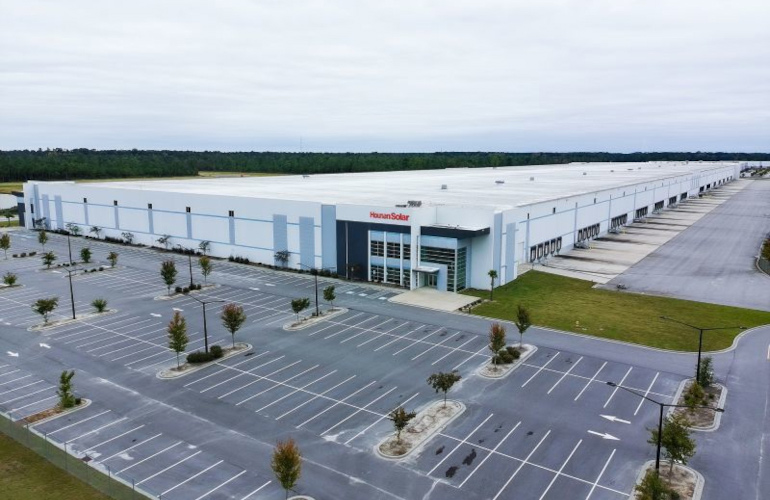
Hounen Solar, a solar panel assembly company headquartered in South Carolina, announced that it will open a second manufacturing location in the state. By joining the company's existing 1-gigawatt factory in Orangeburg, Hounen will establish a 3-gigawatt facility in Summerville by the end of 2026. Hounen has been producing silicon solar panels in Orangeburg since 2024. The site located in Summerville was previously occupied by a home goods manufacturer, so Hounen only needs to bring component assembly equipment. The facility will adopt advanced automation and intelligent production systems to ensure the manufacture of efficient solar modules that meet US market standards, "Hounen said on its website. This strategic investment reflects Hounen's long-term commitment to domestic manufacturing, technological innovation, and supply chain resilience in the United States, contributing to the country's transition to a sustainable and secure clean energy future.

S-5! A company that provides solar energy and metal roof accessories has developed a fixture for solar carport applications. The S-5-CP fixture (CP stands for carport) is designed to accommodate "C" and "Z" - shaped purlin frame structures and uses non penetrating attachments for solar applications. Its design prevents corrosion by eliminating the need for drilling. Carport solar is one of the fastest-growing fields in attachment technology, "S-5! CEO and founder Rob Haddock said. The S-5-CP fixture enables engineers and installers to use the trustworthy S-5! Design a more powerful, simpler, and cost-effective solar carport system using technology. ” Fixture and S-5! ’The PVKIT solar installation solution is used in conjunction to achieve trackless solar panel installation and reduce the number of installation parts. By using the bottom adjustment screw, installation can be carried out under the cover. The bottom adjustment screw is convenient for wiring and maintenance, and allows for on-site adjustment. When installing EPDM gaskets between modules, S-5! Garage systems can reduce the risk of leaks. Using S-5-CP fixtures, engineers and contractors can choose their preferred purlins and spacing. From the roof to the garage, our team continues to innovate and adapt our accessory technology to meet the needs of solar energy applications, "Haddock said. The S-5-CP fixture transforms underutilized space into a valuable clean energy resource, making it an ideal solution for contractors and developers seeking reliable and waterproof solar energy integration into hood structures
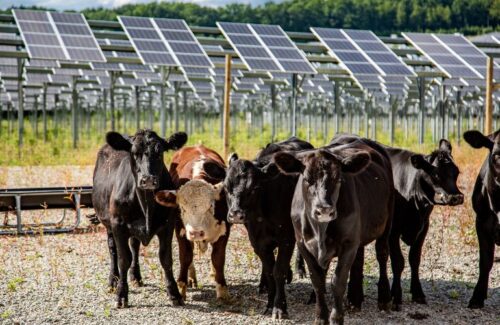
Across the United States, energy demand is surging after decades of stagnant growth due to electrification efforts, data centers, and the development of artificial intelligence. As demand increases, the economics of wind and solar energy continue to lean towards them, as they always have cost-effectiveness advantages over natural gas and coal. When rural communities seek to increase renewable energy, a unique opportunity arises. Flat, sunny, and easily accessible land is very suitable for solar farms, but it is usually already used for agriculture. A new report points out that by expanding the use of complementary agriculture and photovoltaics, renewable energy generation can be increased, water consumption can be reduced, and production can be increased, bringing dual benefits to renewable energy and agricultural communities. Agricultural photovoltaic complementarity - integrating solar panels and active agriculture on the same land - provides a solution that benefits all three core stakeholders. Landowners have gained a new and stable source of income in volatile industries while maintaining the agricultural productivity of their land; Developers of solar energy projects can access feasible locations for the Feiwer license dispute; The community, on the other hand, maintains the production of agricultural land while enjoying local investment and tax revenue. The recent short film, "Saving the Farm, Saving the Future," also highlights the benefits of agricultural photovoltaic complementarity. Agricultural photovoltaic complementarity demonstrates that agricultural production and solar energy development can be complementary options for land use, rather than competitive options, "said Asher Salkin, former research intern at IEEFA and author of the report. Our research shows that using agricultural photovoltaic complementarity in agricultural environments can increase crop yields in areas with water scarcity, which not only reduces operating costs but also improves soil and ecosystem health Although still not widespread, agricultural photovoltaic installations are expanding, growing from 27000 acres and 4.5 gigawatts of capacity in 2020 to over 62000 acres and 10 gigawatts by 2024- enough to power 1.5 million households. With supportive policies, agricultural photovoltaics can help small farmers meet the growing demand for electricity and bring more rural communities into the energy transition.
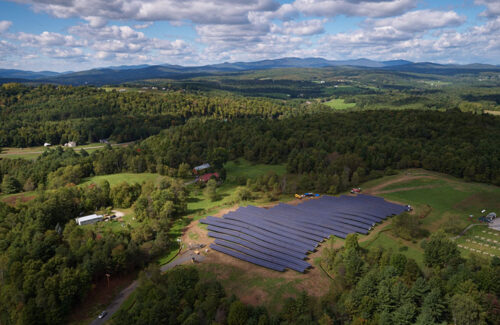
Dispatch Energy, headquartered in New York, announced the acquisition of Green Lantern Solar, a community and commercial solar developer in Vermont. Dispatch Energy, Established in 2024, it will acquire over 64 solar and battery energy storage projects at different stages of development and operation from GLS, totaling 208.9 MW DC. This acquisition expands Dispatch's business presence in the growing distributed generation market in Georgia, Maryland, West Virginia, New York, New Hampshire, Vermont, Maine, Minnesota, and Wisconsin. Dispatch remains committed to the energy transition, and we are pleased to welcome Green Lantern's team, operations, and assets to our portfolio, "said Richard Dovere, CEO of Dispatch Energy. We are proud to have the opportunity to acquire this excellent business led by its founder Dispatch will acquire all of Green Lantern's businesses, including operational and early-stage development assets, as well as its operations and maintenance services business. This acquisition provides excellent results for GLS shareholders and employees, "said Luke Schulenburg, founder and CEO of Green Lantern Solar. We appreciate the execution oriented approach of the Dispatch Energy team and believe that under their leadership, the business will continue to grow in the future
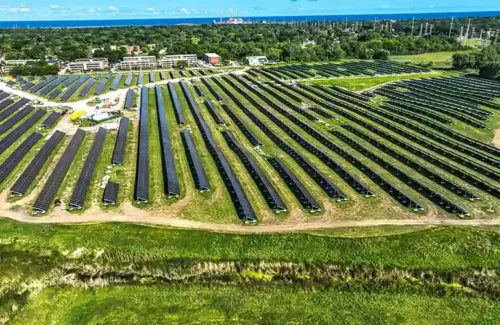
CleanCapital announced the completion of two brownfield solar development projects - the Yeoman solar project in Waukegan, Illinois and the Little Elk solar project in Elkton, Maryland. The Yeoman Solar Project, expected to be put into use by the end of 2025, is a 9.15-megawatt community solar project located on the Yeoman Creek Landfill Superfund website, which is a site undergoing environmental remediation. Waukegan Community School District No. 60 is part of the US Environmental Protection Agency Superfund website that has been transformed into an energy generation center. The Yeoman Solar Project is involved in Illinois' solar program for low-income communities, offering a 50% electricity discount to low-income Waukegan households, resulting in annual savings of approximately $400 per household. CleanCapital has partnered with PowerMarket to manage subscriber engagement and registration, and has expanded anchor subscription opportunities to Waukegan Community School District 60, further strengthening community connections. The Yeoman solar project is the largest community solar facility in the ComEd service area, and its completion is a significant milestone for CleanCapital and an important event for Waukegan customers looking to reduce energy costs, "said Gil Quiniones, ComEd President and CEO. We look forward to continuing to collaborate with CleanCapital to enable the company to connect more renewable energy to the grid and provide more benefits to ComEd customers. ” The Little Deer Solar Energy Project, with a capacity of 822 kilowatts, is also planned to be put into operation by the end of 2025. The project is located on the website of the US Environmental Protection Agency Superfund and was once the site of a paper mill and solvent recovery facility. This project marks an important step in repurposing polluted land for clean energy generation. Before the development began, the project was acquired by CleanCapital as part of its acquisition of BQ Energy, a national leader in the long-term development of renewable energy for landfills and brownfields. The Little Deer Solar Project is expected to generate 1084 megawatt hours of electricity annually and will provide energy under a pilot project for community solar power systems in Maryland, with at least 50% of the energy used to serve low to middle-income (LMI) customers in the Delmarva area. Both solar projects emphasize the transformative potential of developing brownfield and Superfund websites into productive renewable energy generation assets, "said Paul Curran, Chief Development Officer of CleanCapital. Projects like this are ones that the CleanCapital team enjoys investing in and developing because they will bring affordable and reliable energy to the local community, helping them reduce their monthly electricity bills
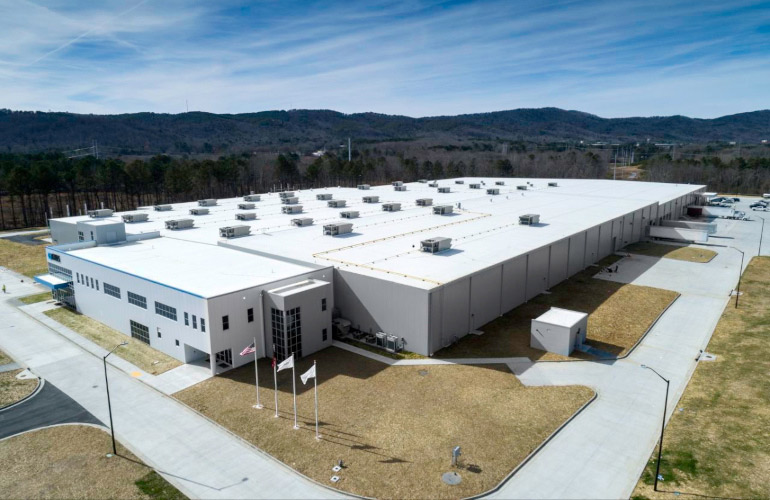
Solar panel manufacturer Q-cells revealed on Friday that it will lay off one-third of its workers at two factories in Georgia. 1000 employees will temporarily have their salaries reduced and working hours shortened due to the increased detention of solar cells and other upstream panel components by the US Customs and Border Protection (CBP). Q-cells will also lay off 300 workers employed by two factories through talent agencies. The federal government has strengthened the enforcement of the Uyghur Forced Labor Prevention Act (UFLPA), which restricts the entry of Chinese goods manufactured using forced labor into the United States. CBP began to detain silicon solar cells manufactured by South Korean company Qcells this summer. Qcells has repeatedly stated that its products do not use Chinese components. The company has long used OCI's polysilicon from South Korea and components from Southeast Asia for manufacturing. Qcells stated that their goods are currently passing through customs, but they will need to temporarily reduce their working hours during this period. Although Qcells is one of the earliest manufacturers in China to start building new solar cell and wafer manufacturing facilities, the company currently only assembles modules in the United States and still requires a stable supply of solar cells to complete module assembly. Similar CBP detention has already affected Maxeon, a solar panel manufacturer partially funded by China but without any documentation linking it to forced labor in China. Despite Maxeon providing thousands of pages of documentation proving its full compliance with UFLPA, its solar panels assembled in Mexico have been banned from entering the United States since the summer of 2024. Maxeon has filed a lawsuit with the US International Trade Court and is awaiting updates during the government shutdown. For Maxeon, this is a company that was once globalized and now only focuses on the US market. Maxeon has sold its sales channels and entities in Europe, Asia, and Latin America, while retaining its assembly plant in Mexico and planning to build a 2-gigawatt solar panel factory in New Mexico. Due to the inability of most products to enter the country, Maxeon's financial situation has significantly declined. The company reported that its revenue for the first half of 2025 was $390 million, compared to $371 million for the same period in 2024. The plan for the American factory has been suspended. Marta Stoepker, Senior Director of Communications at Qcells, stated in a statement to local news that the company had to halt production "because our goods were delayed during customs clearance in the United States Qcells is expected to resume full production in the coming weeks and months. Our commitment to establishing a complete solar energy supply chain in the United States remains unchanged, "she continued. Our Georgia team will soon return to full capacity to bring American made energy to communities across the country
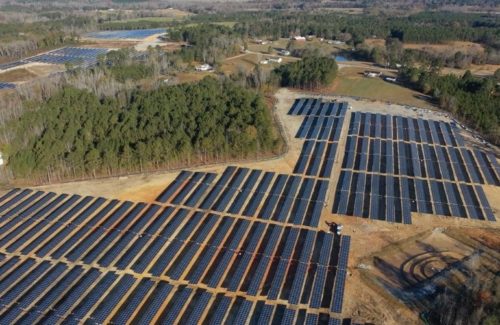
National solar developer Pine Gate Renewables is filing for Chapter 11 bankruptcy and selling its portfolio of solar and energy storage projects as well as its independent power producer business. This will include ongoing and developing projects, with the company stating it has 10 gigawatts of direct current. According to the press release announcing the bankruptcy of the company and the sale of assets, Pine Gate plans to continue its operations through this transaction. In September, Blue Ridge Power, the engineering, procurement, and construction subsidiary of Pine Gate Renewables, submitted a state warning notice to lay off over 500 employees on November 18th. ACT Power Services, the operations and maintenance subsidiary of Pine Gate, has not filed for bankruptcy, but the company is in discussions to sell the business. To ensure that our project continues to generate renewable energy, we have made a strategic decision to initiate this court supervised sales process, "said Ben Catt, CEO of Pine Gate. He continued, 'I am grateful for the hard work and dedication of our Pine Gate team, who have been helping us drive the transition to renewable energy.'. As we go through this process, we remain committed to supporting the valuable project partners of over 100 solar facilities we operate, and continue to advance the projects we are developing and constructing. ” Pine Gate was founded in 2016 and serves the commercial and utility solar markets in 32 states. The company last appeared on the list of top solar contractors for 2023 and installed nearly 500 megawatts of solar energy in 2022. Pine Gate plans to complete bankruptcy related transactions within 45 days after yesterday's announcement.
Categories
New Products
Tin Roof Rapid Solar Mounting System with Hanger Bolt Read More
Residential Small Solar Easy Bracket Kit for Home Balcony Read More
Automatic Single Pile Solar Tracker with 10 PV Panels Read More
Angle Adjustable Aluminum Easy Solar Panel Bracket for Garden Read More
Intelligent Single Post Dual Row Solar Tracking System Read More
5000ES Solar Off-Grid Energy Storage Inverter Supplier Read More
Multi Drive Double-Sided Single Axis Tracker System Read More
© Copyright: 2025 Xiamen Wintop New Energy Tech Co., Ltd.. All Rights Reserved.

IPv6 network supported
Friendly Links:
Integrated Solar System